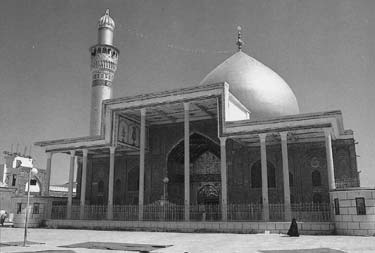![]()
Write us!
[email protected]
Samarra: An Entire City Up in Arms
By May Ying

Samarra is a town of 200,000 inhabitants. While Baghdad and Falluja have witnessed high-profile bombings, Samarra has been quietly engaged for months in an escalating mini-war with U.S. occupation forces.
Until a few weeks ago, the U.S. military had two camps within the Samarra city limits. But incessant mortar attacks, at all hours of the day and night, forced them to a grain silo in the desert several kilometers out of town.
A visit to the U.S. headquarters brings two hulking plain-clothes officers to the gate, while a sullen soldier leans out of a distant doorway to stare at the unusual spectacle of a visitor.
“What do you want?” they ask, politely. “Give us identification,” they demand. “Leave now—it’s about to get ugly here. They are going to start up again,” the officers say.
A few blocks from the U.S. fortress is one of the holiest sites for Shias in the world, the Ali al-Hadi Shrine. The rest of the city and its economic life are wrapped around this spiritual center.
Suddenly the street explodes with insurgent RPG and light weapons fire. A U.S. tank patrol returns fire down a main avenue sending residents scurrying through the intersection, taking refuge in groups behind corners, daring one by one to peer down the street at the sandy collection of U.S. tanks.
“All of Samarra is with the resistance,” explains Muhammad, a local resident. “The guerrillas in Samarra can shoot at the Americans on a sidewalk in the middle of town at noon knowing no one will report them. When they do this, the people clap—men, women and children. The Americans, must get out of Samarra and out of Iraq. We will never tolerate their staying; our religion does not allow it.”
He explains that there is an Islamic as well as a much larger secular resistance movement in Samarra, including Baathists, and people who are simply nationalists or patriots, or want revenge for family members killed or injured by occupation forces
Relatives
Everyone seems related one way or another. Unlike cities like Ramadi and Falluja, which have hundreds of tribes, Samarra has only seven. This makes the already powerful network of blood and tribal ties even more encompassing. No one wants to betray a member of one’s own family or tribe. No one wants to make trouble between his tribe and another. Those who talk to the Americans are considered pariahs to be shunned.
“The Americans,” says Muhammad, “made many enemies for themselves here—by their raids, arrests and firing on people. The U.S. forces have never understood the personality of the Iraqi people. They throw us on the ground and put their feet on our heads. This makes us crazy.”
The resistance in Samarra was born in the spring of 2003. According to the story, now legend, there was a wedding party in the streets. U.S. forces mistook celebratory gunfire for an attack and fired on the wedding party killing four and injuring 15. That same night saw three hours of attacks on the American camp, and from that day, the daily acts of resistance began.
At the town’s only hospital, the ledger clearly records Samarra’s ongoing state of war. Every few days six or seven Iraqis are dead from gunfire and shrapnel, as many as 20 on average a week. Relations with the Americans were not always so grim. When U.S. troops first arrived in Samarra, the city’s elders acquiesced without a shot.
Sayyid Riyadh al-Kilidari is the custodian of the Ali Al-Hadi Shrine. “They came here with satellite dishes and a bunch of newspapers. I can’t remember the names. Have they brought anything else good? If they did, I can’t remember it.”
In October, U.S. forces arrested al-Kilidari himself. “They put a bracelet on me with my name and number that said ‘U.S. attack,’” he said chuckling to himself.
Samarra residents don’t deny the city had been a Baathist stronghold. But they seem to bridle especially at the suggestion they liked Saddam Hussein. “There were a lot of Baathists in this town,” acknowledges al-Kilidari. Some of the original founders of the Iraqi Baath party were from Samarra. “But they were real Baathists,” says Kilidari, “They supported Arab nationalist ideas, not Saddam Hussein.”
When Saddam Hussein came to power in 1979, he exiled, killed or jailed some leaders from the town. In 1991, Samarra was asked to send volunteers to help put down a Shia uprising in Karbala, but the city refused. By 1998, the town’s most important community and religious center, the Big Mosque, had become a meeting place for dissidents plotting to assassinate Uday, son of the president. That year Saddam executed 11 citizens of Samarra and imprisoned seven others for their alleged role in the plot.
One of them, Adnan Thabit Mahir, emerged from five years in Abu Gharaib prison and is now head of the U.S.-appointed Samarra City Council. As such, he is one of the sole communication channels between the angry city and the U.S. military.
Even Thabit, who is accused by his constituents of collaborating with the occupation, has little good to say about the Americans. “They haven’t re-built anything in Samarra and they haven’t invested anything here either,” he says. Those opposed to the occupation like Muhammad say that even if the U.S. sets a withdrawal date they will not believe it. The Americans have no credibility here. We will believe they are going when we see them leave,” he says.
—Al Jazeera, December 3, 2003

Write us
[email protected]